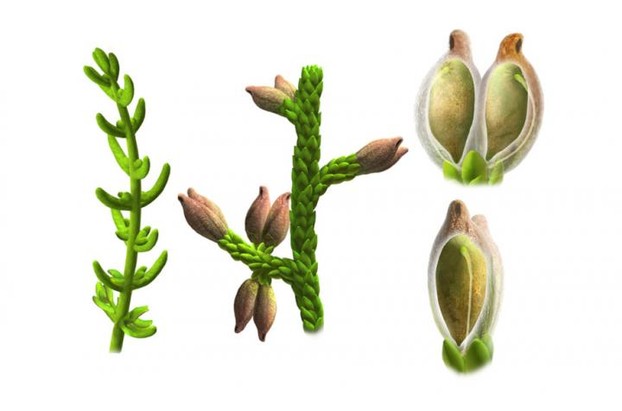AFP. 17 August 2015. “Plant from 130 Million Years Ago is Among ‘First Flowers’: Study.” Yahoo! News > Science. Retrieved August 2015.
- Available @ http://news.yahoo.com/plant-130-million-years-ago-among-first-flowers-215423583.html;_ylt=AwrBT9Tpo.BVSPMAZspXNyoA;_ylu=X3oDMTByMHZ0NG9yBGNvbG8DYmYxBHBvcwM3BHZ0aWQDBHNlYwNzcg--
“Ancient Underwater Plant ‘Could Be World’s First Flower.’ BBC News > US & Canada > 18 August 2015. Retrieved August 2015.
- Available @ http://www.bbc.com/news/world-us-canada-33969640
Baird, Will. 17 August 2015. “Montsechia vidalii: Earliest Known Flowering Planet Discovered in Hautervian Cretaceous Spain.” The Dragon’s Tales: Ramblings of a Curiosity Seeker. Retrieved August 2015.
- Available @ http://thedragonstales.blogspot.com/2015/08/montsechia-vidalii-earliest-known.html
Buchmann, Stephen. 2015. The Reason for Flowers: Their History, Culture, Biology, and How They Change Our Lives. New York; London UK; Toronto; Sydney; New Delhi: Scribner.
“Earth’s First Flower?” Smithsonian National Museum of Natural History > Science News. Retrieved August 2015.
- Available @ http://www.mnh.si.edu/museum/news/firstflower/
Eck, Allison. 25 August 2015. “The World’s Oldest Flower Could Harbor Life-Saving Secrets of Ancient Pollination.” WGBH Educational Foundation > PBS Online > Nova Next > Evolution. Retrieved August 2015.
- Available @ http://www.pbs.org/wgbh/nova/next/evolution/the-worlds-oldest-flower-could-harbor-life-saving-secrets-of-ancient-pollination/
Fryling, Kevin. 17 August 2015. “IU Paleobotanist Identifies What Could be the Mythical ‘First Flower’.” Indiana University Blooming > IU Bloomington Newsroom. Retrieved August 2015.
- Available @ http://news.indiana.edu/releases/iu/2015/08/first-flower-angiosperms.shtml
Gomez, Bernard. “Montsechia vidalii (IMAGE).” EurekAlert! > Multimedia. Retrieved August 2015.
- Available @ http://www.eurekalert.org/multimedia/pub/97290.php
Gomez, Bernard; Daviero-Gomez, Véronique; Coiffard, Clément; Martîn-Closas; and Dilcher, David L. 12 August 2015. “Montsechia, An Ancient Aquatic Angiosperm.”Proceedings of the National Academy of Sciences of the United States of America > Early Edition. doi: 10.1073/pnas.1509241112
- Available @ http://www.pnas.org/content/early/2015/08/12/1509241112
Griffiths, Sarah. 17 August 2015. “World’s First ‘Flower’ Revealed: 130-Million-Year-Old Aquatic Plant May Have Been Eaten by Dinosaurs.” Daily Mail > Latest Headlines > Science > Pictures. Retrieved August 2015.
- Available @ http://www.dailymail.co.uk/sciencetech/article-3201101/World-s-flower-revealed-130-million-year-old-aquatic-plant-eaten-dinosaurs.html
Haines, Lester. 18 August 2015. “Boffins Identify World’s (Possibly) First Flowering Plant: 130-Million-Year-Old Fossils May be ‘Mythical’ Angiosperm.” The Register > Science. Retrieved August 2015.
- Available @ http://www.theregister.co.uk/2015/08/18/worlds_oldest_flower/
Khan, Amina. 17 August 2015. “’First Flowers’ May Have ‘Bloomed’ in Water, not on Land, Fossils Suggest.” Los Angeles Times. Los Angeles Times > Science / Science Now. Retrieved August 215.
- Available @ http://www.latimes.com/science/sciencenow/la-sci-sn-first-flowers-water-not-land-fossils-20150817-story.html
N.Bg. avec AFP. 19 August 2015. “La plus ancienne fleur du monde a été identifiée.” 20 Minutes > Sciences. Retrieved August 2015.
- Available @ http://www.20minutes.fr/sciences/1668855-20150819-plus-ancienne-fleur-monde-identifiee
Osborne, Hannah. 17 August 2015. “Mythical ‘First Flower’Potentially Discovered to be 130 Million-Year-Old Montsechia vidalii.” International Business Times > Science. Retrieved August 2015.
- Available @ http://www.ibtimes.co.uk/mythical-first-flower-potentially-discovered-be-130-million-year-old-montsechia-vidalii-1515831
pskhun. 19 August 2015. “[PaleoBotany 2015] Montsechia vidalii An Ancient Aquatic Angiosperm.” Novataxa > Species New to Science. Retrieved August 2015.
- Available @ http://novataxa.blogspot.com/2015/08/montsechia.html
PTI. 19 August 2015. “Oldest Flowering Plant Bloomed in Shadow of Dinosaurs.” Live Mint > Politics. Retrieved August 2015.
- Available @ http://www.livemint.com/Politics/Hk12zCLlAVQdYnjR4sFdfM/Oldest-flowering-plant-may-be-125130-million-years-old.html
“Montsechia vidalii: Paleontologists Identify One of Earliest Flowering Plants.” Sci-News.com > Paleontology > Science > 18 August 2015. Retrieved August 2015.
- Available @ http://www.sci-news.com/paleontology/science-montsechia-vidalii-earliest-flowering-plant-03139.html
Sanchez, Nick. 19 August 2015. “World’s Oldest Flower Grew in Fresh Waters of Spain 130M Years Ago.” Newsmax.com > The Wire. Retrieved August 2015.
- Available @ http://www.newsmax.com/TheWire/worlds-oldest-flower-spain/2015/08/19/id/670758/
Sanisidro, Oscar. “Montsechia vidalii Illustrations.” EurkAlert! > Multimedia Gallery > Marine Science Portal. Retrieved August 2015.
- Available @ http://ekaweb02.eurekalert.org/multimedia/msp/pub/97291.php
Schneider, Caitlin. 26 August 2015. “World’s Oldest Flower Likely Lived Among the Dinosaurs.” Mental Floss.com > Biology > Botany > Fossils. Retrieved August 2015.
- Available @ http://mentalfloss.com/article/67839/worlds-oldest-flower-likely-lived-among-dinosaurs
Thomson, Helen. 17 August 2015. “Fossilised Remains of World’s Oldest Flower Discovered in Spain.” The Guardian > Science. Retrieved August 2015.
- Available @ http://www.theguardian.com/science/2015/aug/17/fossilised-remains-worlds-oldest-flower-discovered-cretaceous?CMP=share_btn_tw
Winter, Stuart. 18 August 2015. “World’s Oldest ‘Flower’ Is Thought to be 130 Million Years-Old.” Express Home of the Daily and Sunday Express > News > Nature. Retrieved August 2015.
- Available @ http://www.express.co.uk/news/nature/599084/World-s-oldest-flower-Montsechia-Vidalii-is-thought-to-be-130-million-years-old













 Are Hawaiian Huakai Po Nightmarchers Avenging Halloween Thursday?on 10/02/2024
Are Hawaiian Huakai Po Nightmarchers Avenging Halloween Thursday?on 10/02/2024
 Mailing Addresses for 2023 Form 4868 Extending 1040 and 1040SR April 15, 2024, Due Dateon 04/15/2024
Mailing Addresses for 2023 Form 4868 Extending 1040 and 1040SR April 15, 2024, Due Dateon 04/15/2024
 Mailing Addresses for 2023 Forms 1040 and 1040SR Filed in 2024on 04/15/2024
Mailing Addresses for 2023 Forms 1040 and 1040SR Filed in 2024on 04/15/2024
 Mailing Addresses for 2022 Form 4868 Extending 1040 and 1040SR April 18, 2023, Due Dateon 04/13/2023
Mailing Addresses for 2022 Form 4868 Extending 1040 and 1040SR April 18, 2023, Due Dateon 04/13/2023



Comments
WriterArtist, Thank you for stopping by.
Me too, I like the looks of this lovely, sadly extinct plant.
Technology serves us so well when it can bring back the past that we may not know about because we walked down one road and there was a fossil on the other. As Unitedstatesian poet Robert Frost wrote, "Two roads diverged in a yellow wood, And sorry I could not travel both."
Hi DerdriuMarriner - Seems as if this lovely plant is extinct. It looks so beautiful with the blossoms and foliage. You have done good research on this old flowering plant.
Mira, The book is interestingly, practicably informative and looks so enticingly pretty in cabinets and on desktops, shelves, and tables!
I ordered it on Kindle and I may order it as a book to give as a gift. Haven't had time to read anything yet.
Mira, Book or Kindle? Both are nice but oh those photographs!
Okay, I ordered it!
I'm tempted to get the book on Kindle but would miss all the beautiful photography. :) I'm also thinking it could make a great gift. I'll probably order it on Kindle after all :)
frankbeswick, You're welcome. I particularly appreciate interactions with fellow plant lovers.
Thanks for this.
frankbeswick, The researchers are proposing a new family called Montsechiaceae because of differences between Montsechia vidalii and its closest modern relatives in the Ceratophyllaceae family.